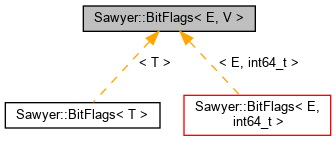Description
template<typename E, typename V = int64_t>
class Sawyer::BitFlags< E, V >
Stores a vector of enum bit flags.
This is a more self-documenting and terse way to use bit flags. For example, consider this original code:
class TableCharacter {
enum Corner { NONE = 0, LEFT = 1, RIGHT = 2, TOP = 4, BOTTOM = 8 };
unsigned current; // bit vector of Corner flags for current character
unsigned previous; // bit vector of Corner flags for previous character
void process(unsigned next) { // next is vector of Corner bit flags
if ((current & LEFT) != 0) {
previous |= LEFT;
current &= ~LEFT;
}
if ((next & TOP) == 0) {
current &= ~TOP;
current |= BOTTOM;
}
}
};
Now rewritten to use this class:
class TableCharacter {
enum Corner { NONE = 0, LEFT = 1, RIGHT = 2, TOP = 4, BOTTOM = 8 };
BitFlags<Corner> current;
BitFlags<Corner> previous;
void process(BitFlags<Corner> next) {
if (current.testAndClear(LEFT))
previous.set(LEFT);
if (next.isClear(TOP))
current.clear(TOP).set(BOTTOM);
}
};
Definition at line 66 of file util/Sawyer/BitFlags.h.
#include <BitFlags.h>
Inheritance diagram for Sawyer::BitFlags< E, V >:

Public Types | |
| typedef E | Enum |
| typedef V | Vector |
Public Member Functions | |
| BitFlags () | |
| Default constructor with all bits clear. | |
| BitFlags (Vector v) | |
| Construct bit vector from value or bit. | |
| BitFlags (E e) | |
| Vector | vector () const |
| Current value of the bit vector. | |
| bool | isSet (Enum e) const |
| Test whether a bit is set. | |
| bool | isAllSet (BitFlags other) const |
| True if all specified bits are set. | |
| bool | isAnySet (BitFlags other) const |
| True if any of the specified bits are set. | |
| bool | isAnySet () const |
| True if any bit is set. | |
| bool | isEmpty () const |
| True if no bits are set. | |
| bool | isClear (Enum e) const |
| Test whether a bit is clear. | |
| BitFlags & | set (Enum e) |
| Set the specified bit. | |
| BitFlags & | set (BitFlags other) |
Set all bits that are set in other. | |
| BitFlags & | clear (Enum e) |
| Clear the specified bit. | |
| BitFlags & | clear (BitFlags other) |
Clear all bits that are set in other. | |
| BitFlags & | clear () |
| Clear all bits. | |
| bool | testAndClear (Enum e) |
| Test whether a bit is set, then clear it. | |
| bool | testAndSet (Enum e) |
| Test whether a bit is set, then set it. | |
| BitFlags & | operator= (Vector v) |
| Set the vector to an exact value. | |
| BitFlags & | operator= (BitFlags other) |
| Set the vector to the same as another. | |
| std::vector< Enum > | split (std::vector< int64_t > constants, Vector &leftovers) const |
| Split a vector into the individual enum values. More... | |
| std::vector< Enum > | split (Vector &leftovers) const |
| Split a vector into the individual bits values. | |
| BitFlags | operator| (BitFlags other) const |
| Create a new vector that's the union of two vectors. | |
| BitFlags | operator| (Enum e) const |
| Create a new vector that's the union of two vectors. | |
| BitFlags | intersection (BitFlags other) const |
| Create a new vector that's the intersection of two vectors. | |
| BitFlags | intersection (Enum e) const |
| Create a new vector that's the intersection of two vectors. | |
| BitFlags | operator& (BitFlags other) const |
| Create a new vector that's the intersection of two vectors. | |
| BitFlags | operator& (Enum e) const |
| Create a new vector that's the intersection of two vectors. | |
| bool | operator== (BitFlags other) const |
| Compare two vectors. | |
| bool | operator!= (BitFlags other) const |
| Compare two vectors. | |
| bool | operator< (BitFlags other) const |
| Compare two vectors. | |
| bool | operator<= (BitFlags other) const |
| Compare two vectors. | |
| bool | operator> (BitFlags other) const |
| Compare two vectors. | |
| bool | operator>= (BitFlags other) const |
| Compare two vectors. | |
Member Function Documentation
◆ split()
template<typename E , typename V = int64_t>
|
inline |
Split a vector into the individual enum values.
The enum constants are first sorted so that those with more set bits appear before those with fewer bits. Then each constant is searched in the bit vector and those bits are removed. This continues until either no bits remain or no matching constant is found. The leftovers is set to those bits that could not be matched by this process.
Definition at line 241 of file util/Sawyer/BitFlags.h.
The documentation for this class was generated from the following file:
 1.8.17
1.8.17